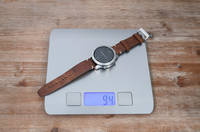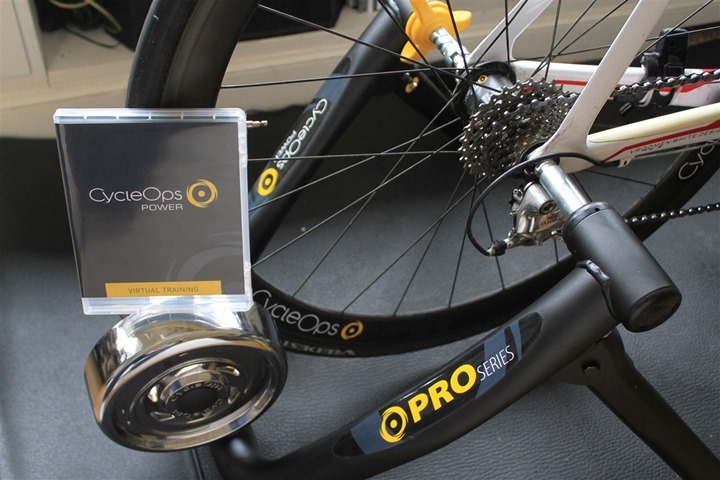Everything you ever wanted to know: Garmin’s new $1,500 Fenix Chronos Watch Series
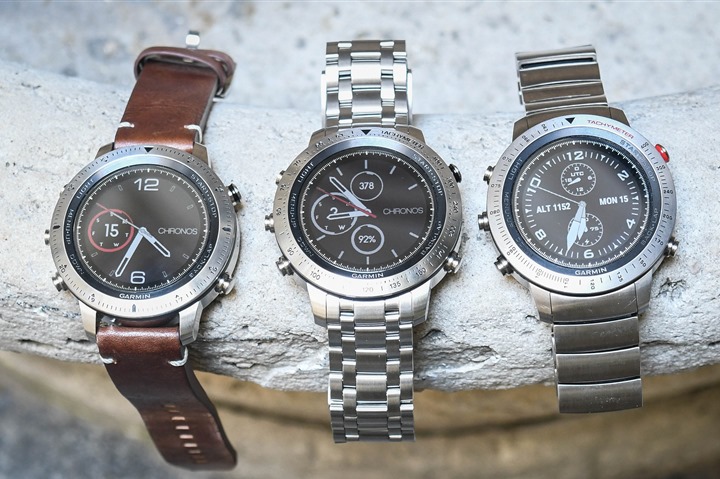
Well then, someone in Kansas is feeling ballsy today. Garmin has just announced three new Fenix units, starting from $900 and topping out at $1,500USD. Or, if you’re so fortunate to be living in the land of maple syrup, it’ll set you back $2,000CAD. This new series, dubbed the Chronos line, takes an existing Fenix3 HR watch and completely revamps the exterior shell. Along the way they give you a fancy new watch face, a nifty stopwatch option, and a solid woody. Wooden box that is.
I’ve spent a bit of time playing with all three new editions, inclusive of some riding. These new editions supplement the already growing collection of now nearly a dozen Garmin Fenix3 models out there – from rose gold to titanium bands and leather strap models. Not to mention the Tactix Bravo, and Quatix 3 variants as well. Full house indeed.
If you’re looking for the end to end overview of what this watch is, start by watching the below video. Think of it as a true executive summary of the Fenix Chronos lineup – complete with me in a suit:
Still looking for more deets after that video? No problem, keep reading and looking at pretty pictures. Because yes, the pictures are definitely pretty here.
The Editions:
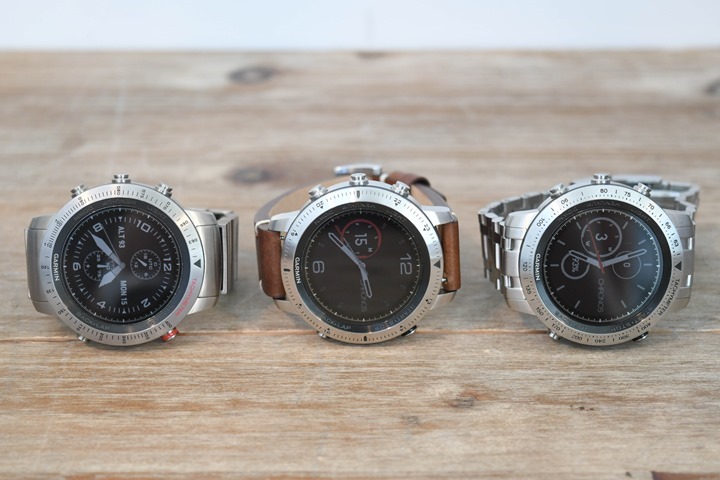
The Chronos lineup is based on the Fenix3 HR. When it comes to features, there is best I can tell only a single hardware feature difference, plus some minor user interface tweaks. Everything else is virtually the same. It’s got the same sport profiles, the same navigation functions, and almost the same optical HR sensor. But more on that sensor in a minute.
First, let’s talk the three editions. They are as follows:
Fenix Chronos Titanium: Contains a brushed titanium case with forged titanium links and buttons: $1499
Fenix Chronos Steel: Contains a brushed stainless steel case, and 316L stainless steel links: $999
Fenix Chronos Steel with leather strap: The same stainless steel casing, but with a ‘Vintage’ leather band: $899
In terms of the titanium edition, it’s forged titanium for the housing, bezel, and buttons.
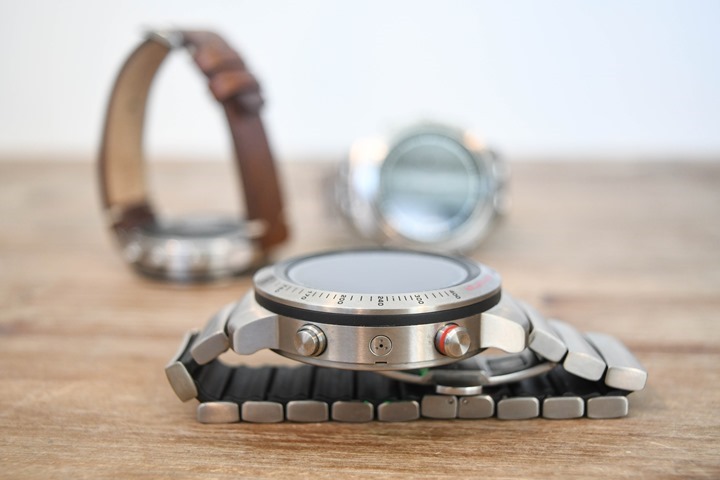
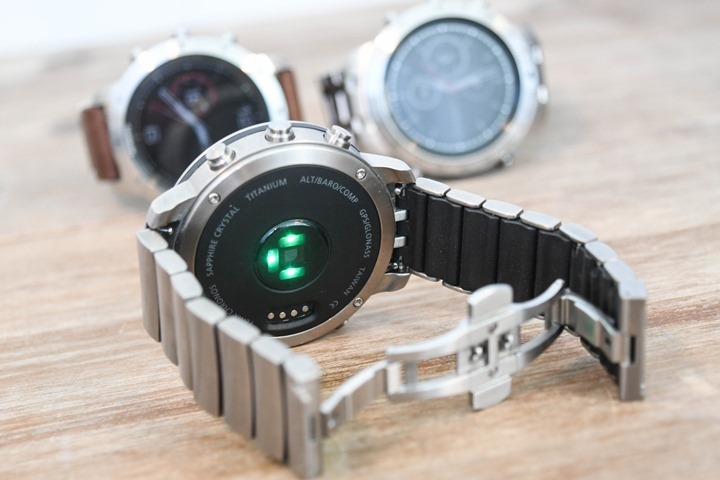
On the steel model, it’s a stainless steel housing and band in an interwoven link pattern.
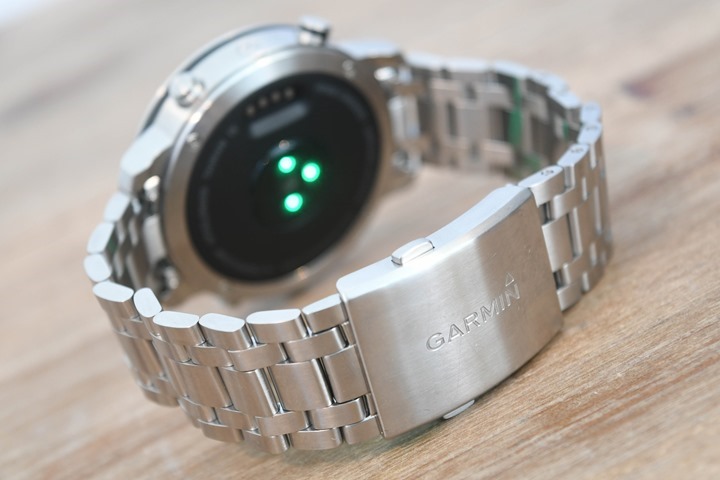
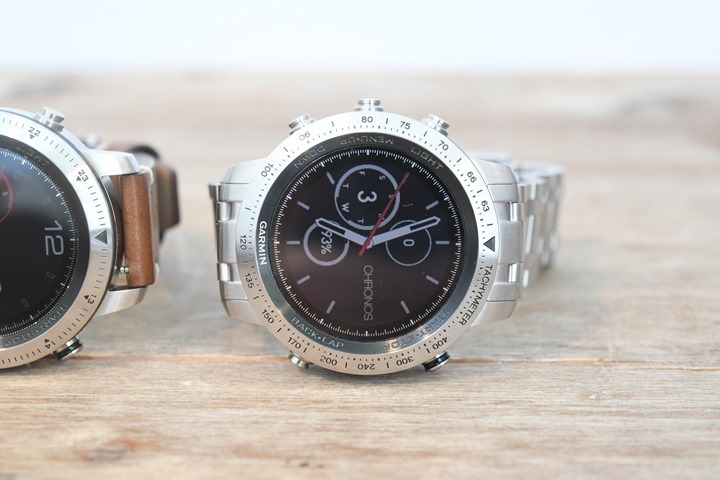
And for the leather variant, it’s the same base watch as the steel, but with a (genuine) Italian leather band:
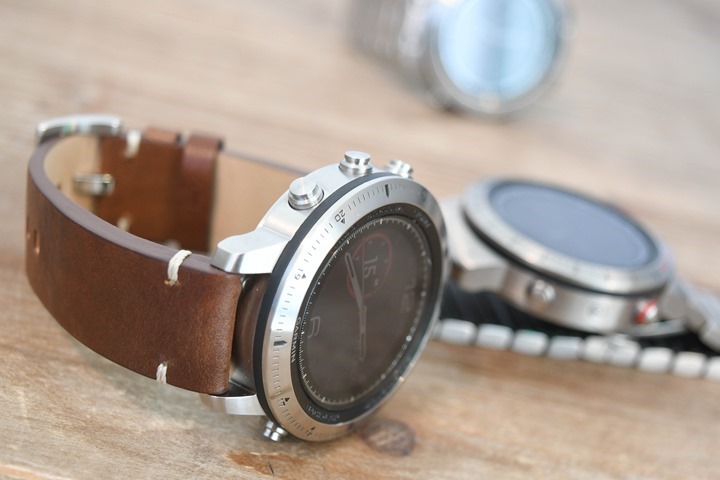
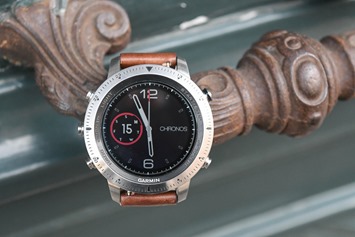
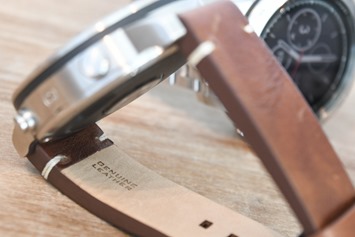
The easiest way to remember the difference between the steel version from the titanium one is that the titanium has the long links, versus the steel that has that interwoven pattern:
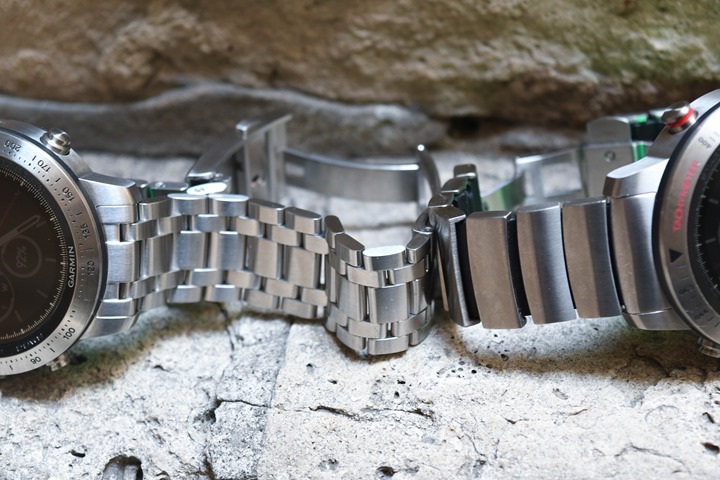
All three units use a sapphire crystal glass, similar to what we’ve seen on the existing higher end Fenix3 lineup. This helps to protect it against scratches.
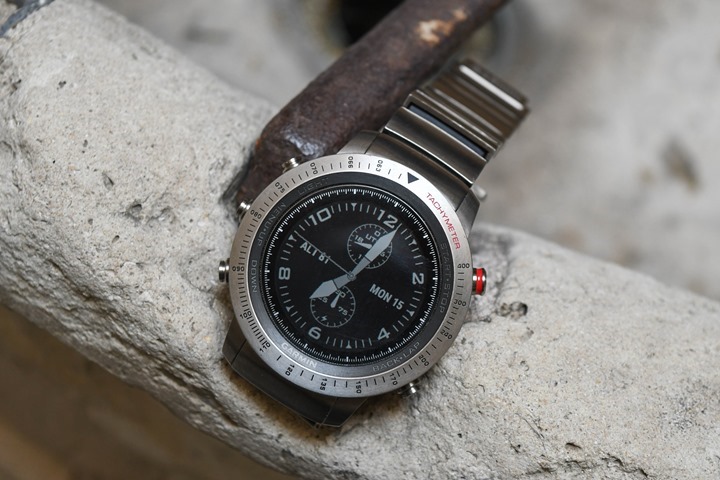
I found that I could easily slip all three models under a dress shirt without any issues:

The weights on them vary of course, based on materials. I’ve weighed them in at the following:
Fenix Chronos Titanium: 103g
Fenix Chronos Steel: 184g
Fenix Chronos Steel with leather strap: 94g
Fenix3 HR: 90g
Fenix3 Sapphire with metal bands: 198g
And here’s a nifty gallery of that:
When it comes to waterproofing, all of them retain the higher end Fenix3 HR waterproofing level of 100m deep (~328ft), and the battery life is the same as the Fenix3 HR at 13 hours for GPS mode, and 25 hours in UltraTrack mode.
While the software is virtually identical, there are three minor features differences I’ve noticed. First is that these watches have unique watch faces not seen on other Fenix3 units. Obviously, with Connect IQ someone could replicate these, though we haven’t really seen this level of styling before.
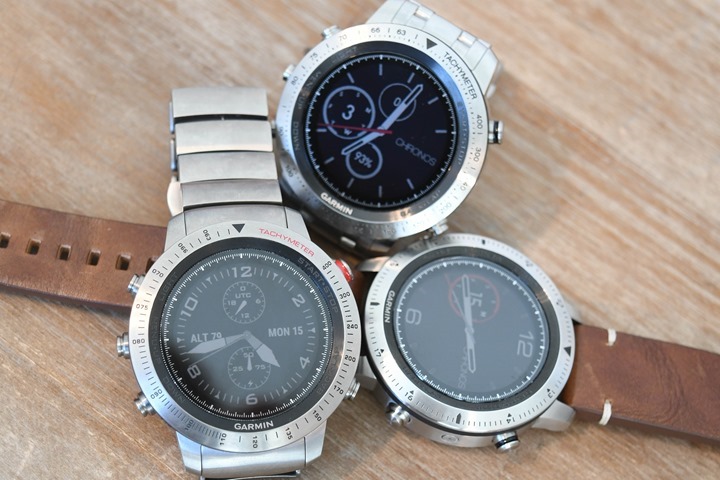
Next, with existing Fenix3 units you press the upper right button to dive into the sports menu. But with the Chronos, that button is red, and red means special.
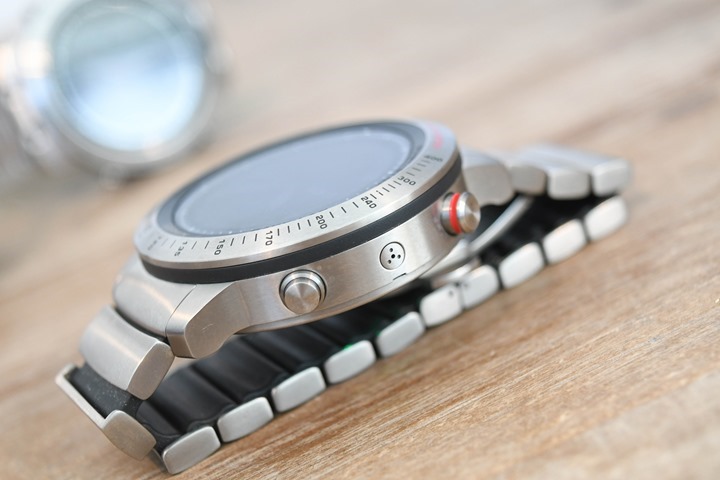
In this case, a long hold will actually take you to a special stopwatch option. You can start/stop the timer, which in the picture below is at 22.35s. In my overview video, I show it working a bit more as well.
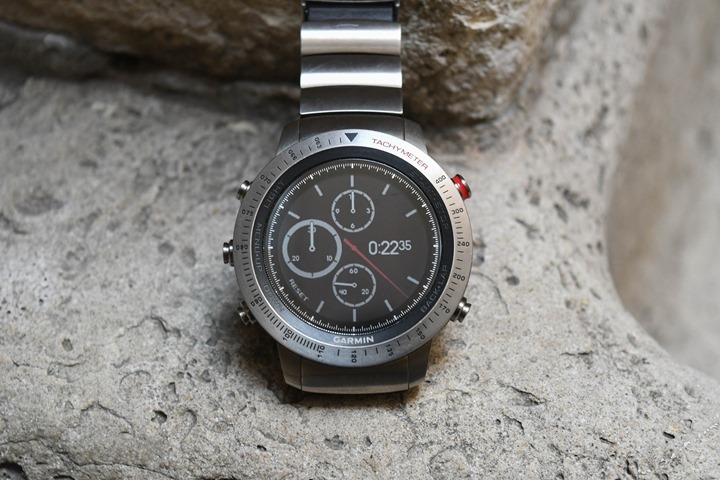
That stopwatch keeps running, even if you go back to the main screen, view text notifications, etc… Pretty cool.
And finally, the third change is more around menu styling. There’s some minor differences in the user interface in terms of styling, with this having more of a rounded edge look in certain menus – such as selecting sport modes:
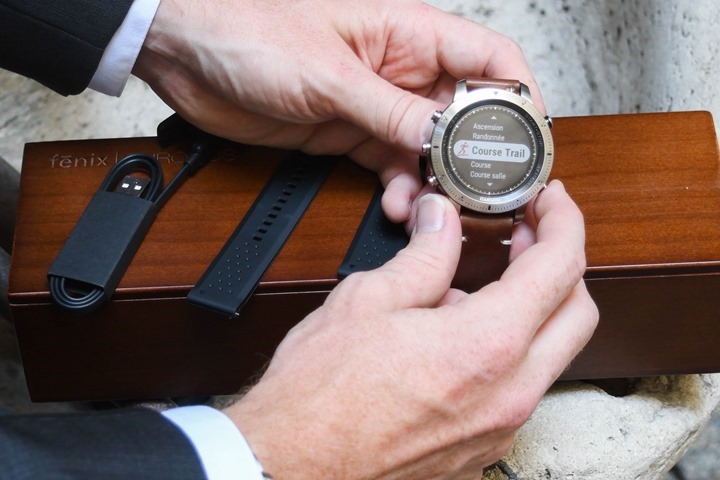
Now interestingly, as I noted earlier I did find one tiny hardware difference compared to a Fenix3 HR, which is a small change in the optical HR sensor components. First, the optical HR sensor of the Fenix Chronos unit is notably flatter (slimmer). The bump has been reduced by about half the height. It’s maybe 1mm of bumpage now, compared to 2mm of bumpage before. Here’s the two units side by side:

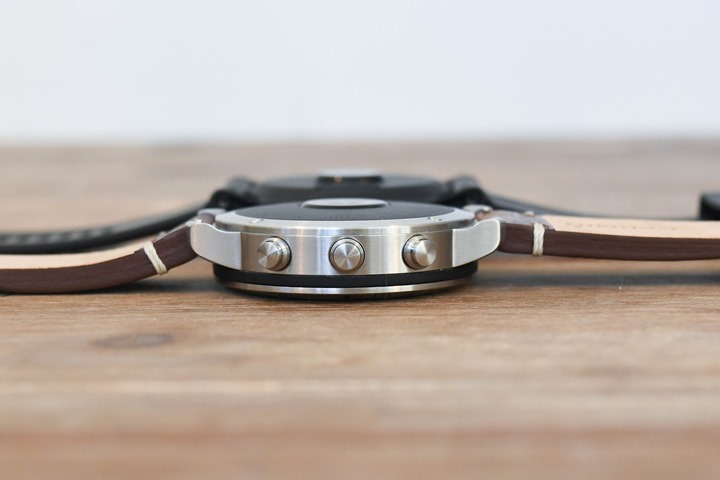
Also note that the Chronos body is slightly slimmer overall than the Fenix3 HR. So it lost a little bit of pudge in there while it was at it.
Next, if you look closely at the optical sensor package when the green light is off, you’ll find they’re using slightly different lights from the Fenix3 HR (the three white dots below). Note how the Fenix3 HR’s lights are squared, versus a more rounded look on the Chronos.
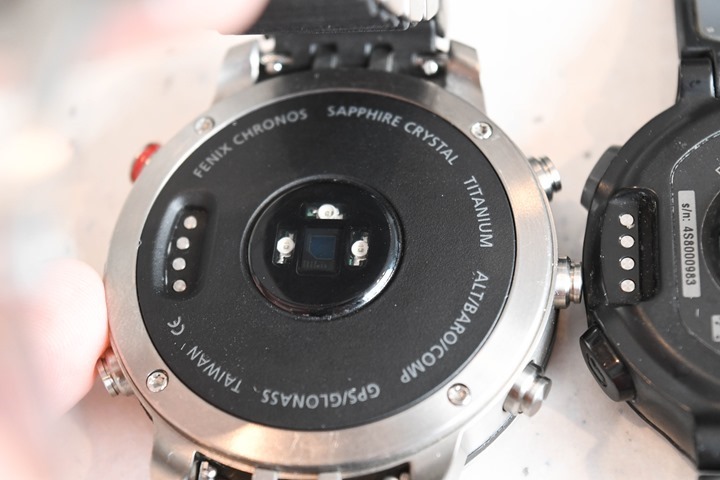
Versus the Fenix3 HR:
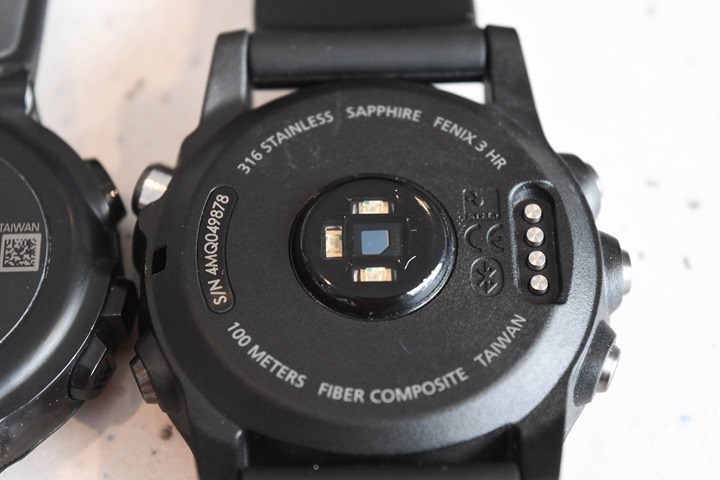
In pulling out the newer Garmin FR735XT, you’ll see this actually matches the Fenix Chronos with the rounded diodes, but differs from the Fenix3 HR.
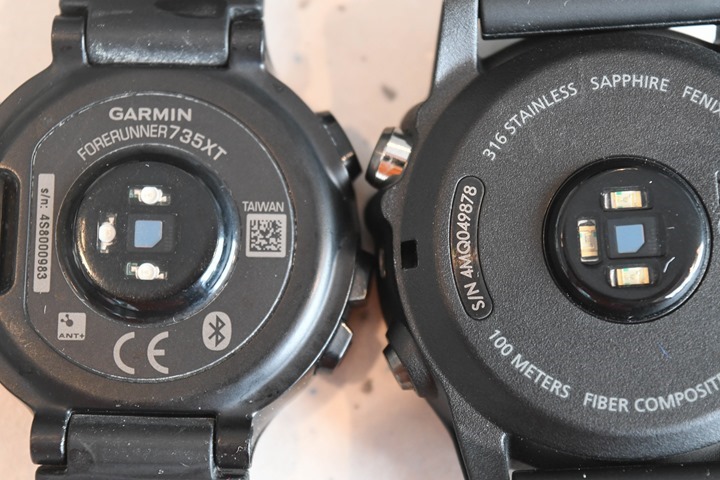
So somewhere along the way Garmin made a slight component change. Whether or not this has any impact to accuracy isn’t clear. Given it appears the same package as the FR735XT, my guess is we’ve already seen those accuracy differences starting with that product. Of course, I suspect most accuracy differences you’ll have seen have more to do with algorithm updates than a swap of the LED’s. Note that in my bike ride section below, I do take a look at HR accuracy though.
Update: Since announcement, Garmin has let slide a few more internals differences to the Fenix3 lineup, most of them minor and focused on Connect IQ – but one is pretty important on the disadvantages side (WiFi). On the upgrades, they are:
- Better processor (faster) – really only relevent for some Connect IQ apps
- More memory for Connect IQ apps
- Support for all of Connect IQ 2 (F3/F3HR get most features, but not all)
- More colors in the display (64 vs 14 colors)
- Garmin Varia Vision support (the heads up display)
Then there are some ‘downgrades’ compared to the Fenix3/Fenix3 HR:
- Smaller battery size (reduces battery life by about 3 hours in GPS mode to 13 hours)
- Removal of WiFi (Fenix3/Fenix3 HR have it)
While some have argued that it’s ‘just a FR735XT’, that’s pretty far from correct. In fact, if you were to outline the differences between the two, it’s far closer to the Fenix3 than the FR735XT. For starters, it has a barometric altimeter and compass – hardware things the FR735XT doesn’t have. Further, it has boatloads of hiking, navigation, and related features that the FR735XT doesn’t have. That makes for a huge software difference here compared to the FR735XT, with the only software commonality to the FR735XT being that Varia Vision support is added. But that’s also available on other Garmin wearables. It is rather odd Garmin hasn’t added support to the F3/F3HR (and they say they won’t either).
On the battery it does have a reduced battery profile, which puts it in a similar box as the FR735XT in terms of battery life. But keep in mind that it’s doing this with a display that’s 64-colors and more processing power.
The Wooden Box:
Of course, for a $1,500 watch you expect something more than just a cardboard box. In the case of the $10,000 Apple Watch (gold variant), it comes in a cardboard shell, but with a leather-looking interior charging case. I’d say that Garmin has slightly stepped it up here. They’ve gone wood.
Yup, every Fenix Chronos unit comes with this super fancy engraved wood case:
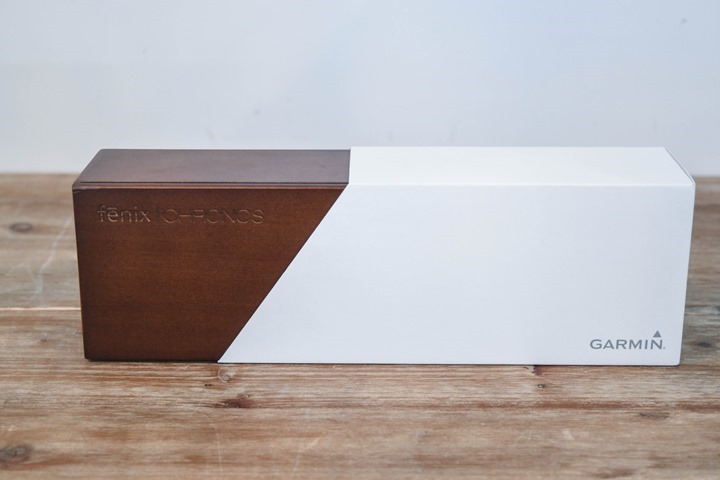
You’ll find it does have an outer paper half-shell though, with the Chronos logo on it.
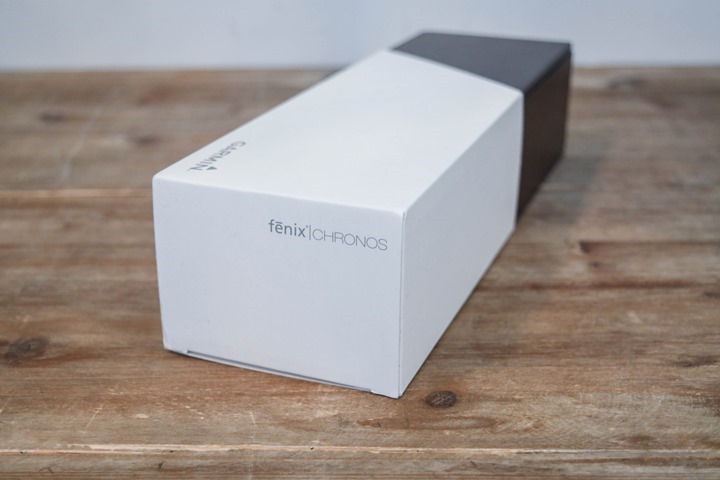
Here’s a better look at that carving/engraving of the wood:
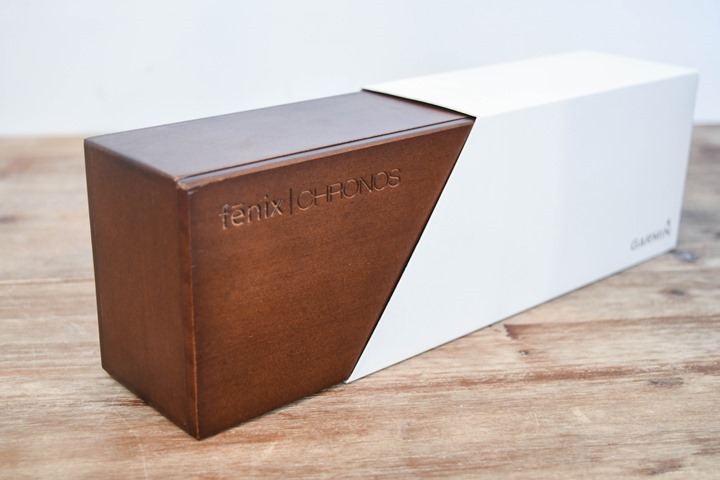
Next, to open it up you’ll find the upper lid slides out and the unit sits below it protected in a hard foam. The underside of the lid also has foam to protect it (as seen in my unboxing video below).
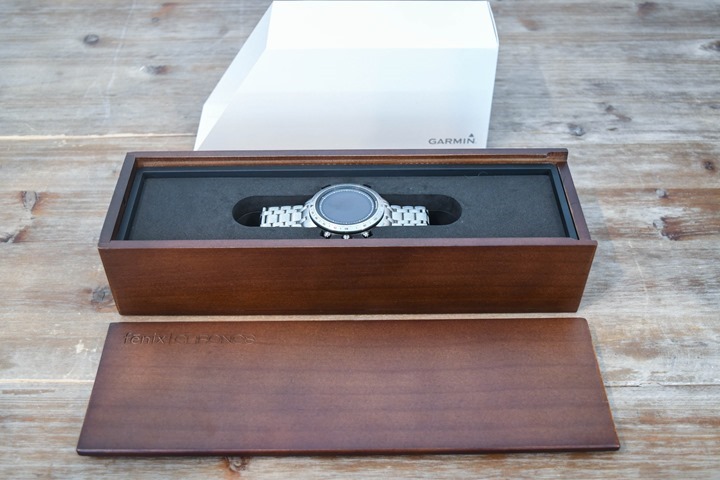
Meanwhile, inside you get a charging cable, a silicone sport band, and a small quick start guide and pile of legal papers.
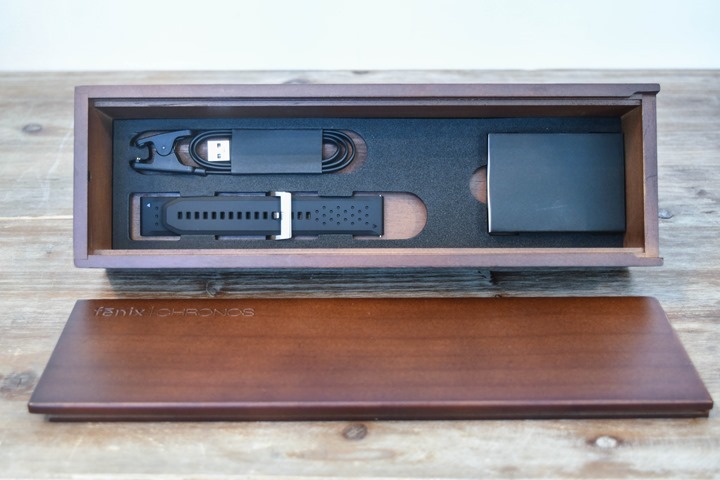
Now both bands have a quick release system that allows you to easily pop it on and off to swap out for sport usage.
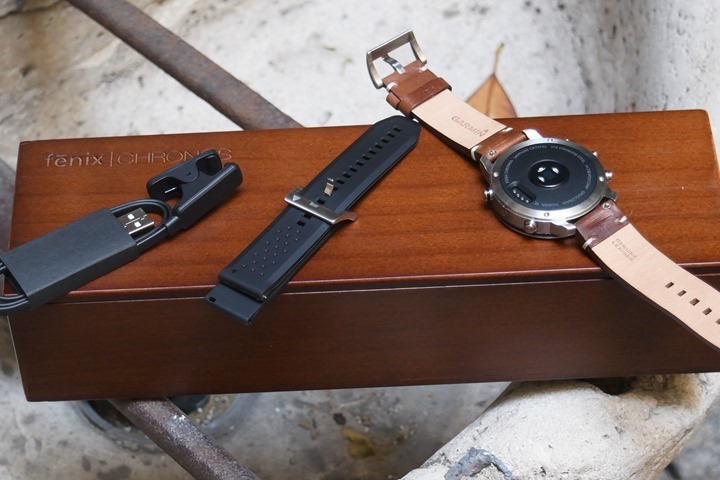
In addition, there’s actually a small change to the charging cable, which is more similar in style to that of the FR735XT than that of the existing Fenix3 lineup. The pin sizing is slightly different, and thus not quite compatible.
Now I do a much more thorough unboxing as part of the below unboxing video – diving into size comparisons with the existing Fenix3 lineup, as well as it just being a more immersive unboxing experience.
A bit of a ride:
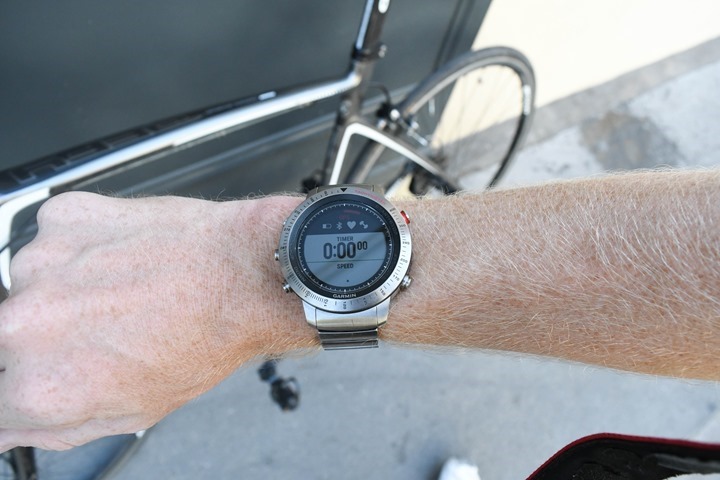
I didn’t have the units for long, as they’re in high demand. But of course I wanted to at least get a ride in with it, despite them being virtually identical to other Fenix3 units. So when it came time to return them, I figured I’d just plunk the most expensive model on my wrist and return them via bike. The other two units were tossed in a small bag on my back.
As I expected, the units acted just like any other Fenix3 unit. It recorded my power meter data from my power meter, and my heart rate from the optical HR strap. No big surprises there. You can see the file here. I also didn’t see any obvious GPS errors either. It handled my cross-city route without issue and matched the Edge 820.

I was of course interested in the HR accuracy piece, to see if anything notable had changed. And overall, it did better than I expected, and better than I’ve typically seen with the Garmin ELEVATE optical HR sensor units while riding. It wasn’t perfect, but if you look at the below comparisons to a HR strap during this ride, it was actually pretty close – only drifting a few times for a few seconds at what appeared to be stoplights and such.

You can dive into the datasets more here in the DCR Analyzer.
Given that this is supposed to be the same tech as existing Fenix3 watches, I wouldn’t expect much difference otherwise, and my ride and other usage seems to support that. Note that at this stage, I do not plan an in-depth review of the Fenix Chronos lineup, since I don’t expect that much demand from readers to re-review something that I’ve already reviewed within the Fenix3 HR In-Depth Review. Just like I didn’t release a new review for the rose-gold edition of the Fenix3 when it came out.
Wrap-Up:
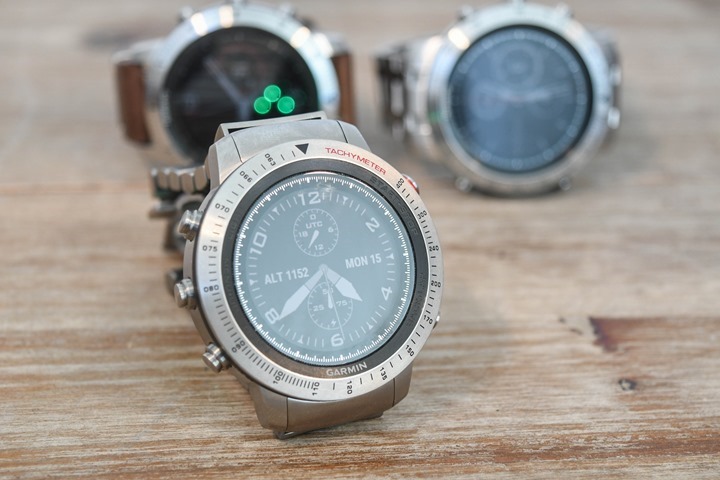
There will undoubtedly be a (large) segment of the population that screams and shouts about Garmin offering a $1,500 Fenix3. But one has to keep in mind there’s plenty of precedent for crazy expensive smart watches. For example, Apple Watch and their $10,000 gold edition, or Tag Heuer’s $1,500 Connected watch. In the case of Tag Heuer, Garmin has a crapton more features, and I’d subjectively say it even looks quite a bit nicer than that watch. And that ignores the higher end non-connected watch world at large, where $1,500 is barely shruggable.
Of course, you won’t find me buying this unit anytime soon – for the same reason you wouldn’t find me buying a $10,000 Apple Watch: Technology evolves too fast. Within just a few short years both watches and their respective operating platforms will be dead-ended, like all technology eventually is. That’s part of the appeal of a classical timepiece – that it can potentially be handed down to another generation and be just as stylish and functional as it might have been 50 years earlier. Would you even be able to find a USB2 or USB3 port 50 years from now to charge it?
Which doesn’t mean there’s anything wrong with buying it. There’s plenty of purchases that we as consumers make for technology that have a short lifespan. For example, TV’s are rarely kept for more than a decade these days, and we spend quite a bit on ensuring we have the fanciest and prettiest looking one on our wall.
And that’s ultimately what the Fenix Chronos series is about: Looking stylish or fancy. It’s appealing to someone that would otherwise wear a non-connected watch in certain social or work settings, but wants all the functionality of a connected (and multisport watch). And that’s a perfectly fine reason, the Fenix3 HR was the most feature capable multisport watch out there, and this simply gives folks more options to choose from that fit their lifestyle best.
With that – thanks for reading!
—
If you do fall into the category of being one of those people who prefers this swankier watch, you can help support the site by hitting up the folks at Clever Training, who are taking pre-orders for the Chronos series now. And, if you use the DCR/CT VIP program, you’ll be able to get back 10% in points as well. Which in this case is a lot of sandwiches at Arby’s worth of points, though, you can’t unfortunately spend them at Arby’s. Still, you get the point.
